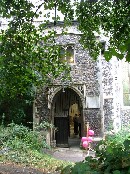
home I index I latest I glossary I introductions I e-mail I about this site
St Peter Parmentergate, Norwich

Read
the captions by hovering over the images, and click on them to
see them enlarged.





| St Peter
Parmentergate, Norwich This is a big, urban church, and its setting is deceptive. It sits in an overgrown graveyard towards the northern end of the Ber Street and King Street area of social housing and rundown warehouses, an area now undergoing bright regeneration; it appears marginalised, and may even seem a little suburban. In fact, it is as close to the castle as St Peter Mancroft or St Andrew, and closer to the Cathedral than either. In past times, this was an important city church. Now, it rests, quietly redundant, and you might think that here is another victim of the Brooke Report, which in 1969 recommended the closure of most of Norwich's medieval churches. Not so. St Peter remained in use, becoming the main church of the Parmentergate group of parishes in the south of the city centre. However, in the early 1980s the church was faced with declining congregations and a massive repair bill, and it was decided to take St John Timberhill out of mothballs, and restore it to use as the main church of the parish. St Julian, to the south of here, acts as a kind of chapel of ease, and so St Peter was closed. St John Timberhill is a small, warm church in the city centre, at the top of Ber Street, easily accessible by the parish. St Julian is a little devotional jewel; but St Peter Parmentergate is a great hulk of a building, and at this distance it is hard to see why this wasn't the outcome in the first place. The church sits on a drastically sloping site, so much so that the Priest door in the chancel has a flight of twelve steps leading up to it from the graveyard. There is a two-storey building set immediately against the east end of the chancel which does nothing to obscure the east window. It is a sacristy of the early 16th century, with a gigantic image niche set in its east wall. You step through the south porch into a wide, bright interior, a sense of openness enhanced by the slightness of the chancel and the fact that it does not climb. The font is particularly pretty, familiar from hundreds of rural East Anglian churches, and you might imagine that it came to the big city on a day trip, and never went home. It is not the only rustic medieval feature here, because the northern side of the rood screen dado also appears to be medieval, with a particularly good St Michael and the dragon in the spandrils. That St Peter was ultra-Anglo-catholic can be deduced from the rich, camp reredos, and a memorial in the north side of the chancel that asks us, of our charity, to pray for the soul of a churchwarden. You'll be reassured to know that this tradition has been carried on at St John Timberhill. On the other side of the chancel is an enormous box, which contains the 1623 Berney memorial. This is intended to protect it, but the glass viewing panel makes photography very difficult. I came here on the National Heritage open day, and found myself in the company of other visitors. I was delighted to meet a couple of friends of the site, who introduced themselves. I hope they have fun spotting themselves in the photographs. As for the future, it would be a great shame if this beautiful open interior was carved up for office space or workshops; it cries out for a use that preserves the internal integrity of the nave. Simon Knott, December 2005 |
Amazon commission helps cover the running costs of this site.
home I index I latest I introductions I e-mail I about
this site I glossary
Norwich I ruined churches I desktop backgrounds I round tower churches
links I small
print I www.simonknott.co.uk I www.suffolkchurches.co.uk